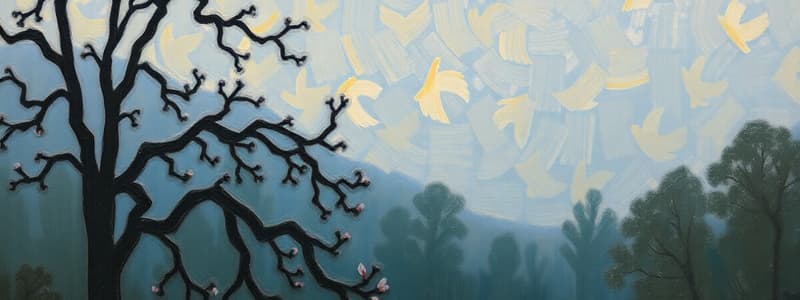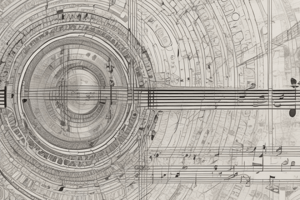Podcast
Questions and Answers
What is timbre in music?
What is timbre in music?
Timbre, or tone color, is the quality of a musical note or sound that differentiates it from other sound production, setting the mood and expressing feelings.
How is the human voice generally classified?
How is the human voice generally classified?
Human voices are generally classified as soprano, alto, tenor, and bass.
Which vocal classification refers to afemale singer with the highest vocal range?
Which vocal classification refers to afemale singer with the highest vocal range?
Soprano
What is an alto voice often referred to as, and what are its characteristics?
What is an alto voice often referred to as, and what are its characteristics?
What defines a tenor voice?
What defines a tenor voice?
What nationality is Jonathan de la Paz Zaens
What nationality is Jonathan de la Paz Zaens
Which male voice type sings in the lowest vocal range?
Which male voice type sings in the lowest vocal range?
What is a large group of instruments playing together called?
What is a large group of instruments playing together called?
Which instrument family makes up more than half of the orchestra?
Which instrument family makes up more than half of the orchestra?
Match the string instrument to its name.
Match the string instrument to its name.
How do woodwind instruments typically produce sound?
How do woodwind instruments typically produce sound?
Match the woodwind instrument to its name.
Match the woodwind instrument to its name.
How are brass instruments typically played?
How are brass instruments typically played?
Match the brass instrument to its name.
Match the brass instrument to its name.
How are sounds typically produced on percussion instruments?
How are sounds typically produced on percussion instruments?
Match the percussion instrument to its name.
Match the percussion instrument to its name.
What is the title given to the head of the orchestra who guides the musicians?
What is the title given to the head of the orchestra who guides the musicians?
What is the largest type of vocal group called?
What is the largest type of vocal group called?
What does it mean for a choir to sing 'a cappella'?
What does it mean for a choir to sing 'a cappella'?
What is contrast in art?
What is contrast in art?
What is harmony in art and design?
What is harmony in art and design?
How is complementary harmony achieved?
How is complementary harmony achieved?
What is monochromatic harmony?
What is monochromatic harmony?
What does analogous harmony involve?
What does analogous harmony involve?
Flashcards
Timbre (tone color)
Timbre (tone color)
The quality of a musical note that differentiates it from other sounds, expressing feelings in music.
Soprano
Soprano
A female singer with the highest vocal range, known for a bright and light quality.
Alto
Alto
A female voice range lower than soprano, characterized by a thick and full sound.
Tenor
Tenor
Signup and view all the flashcards
Bass
Bass
Signup and view all the flashcards
Orchestra
Orchestra
Signup and view all the flashcards
String Family
String Family
Signup and view all the flashcards
Woodwind Family
Woodwind Family
Signup and view all the flashcards
Brass Family
Brass Family
Signup and view all the flashcards
Percussion Family
Percussion Family
Signup and view all the flashcards
Conductor
Conductor
Signup and view all the flashcards
Baton
Baton
Signup and view all the flashcards
Podium
Podium
Signup and view all the flashcards
Choir
Choir
Signup and view all the flashcards
A cappella
A cappella
Signup and view all the flashcards
Contrast
Contrast
Signup and view all the flashcards
Harmony
Harmony
Signup and view all the flashcards
Complementary Harmony
Complementary Harmony
Signup and view all the flashcards
Monochromatic Harmony
Monochromatic Harmony
Signup and view all the flashcards
Analogous Harmony
Analogous Harmony
Signup and view all the flashcards
Study Notes
- Timbre, or tone color, sets the mood and expresses feelings in music.
- It is the quality of a musical note that differentiates it from other sound production, such as voices and instruments.
- A human voice is a special instrument capable of producing sounds and tones in varying timbre.
- Voices are generally classified as soprano, alto, tenor, and bass.
Soprano
- Soprano generally refers to a female singer with the highest vocal range.
- Soprano voices are described as brilliant and light.
- Young boys whose voices have not changed can sing in the soprano range.
- They often replace women's voices in the choir.
Alto
- Alto, often referred to as contralto, has a vocal range lower than soprano.
- Alto voices are described as thick and full.
Tenor
- Tenor refers to a male singer with a high vocal range.
- The name "tenor" comes from the Latin word "tenere," which means "to hold."
- Tenor voices are described as brilliant and thin.
Bass
- Bass refers to a male singer with the lowest vocal range.
- Bass voices are described as powerful and heavy.
- Apart from vocal timbre, instrumental timbre is also present.
- Instrumental timbre is produced by musical instruments.
- A group of instruments that play string, wind, brass, and percussion is called the orchestra.
String Family
- The string family makes up more than half of the orchestra.
- String instruments have strings made from gut, steel, or nylon.
- They may look similar but have very different sizes and sounds.
- They are played by drawing a horsehair bow across the strings, or by plucking or tapping the strings.
- Examples of string instruments: violin, viola, double bass, cello
Woodwind Family
- Woodwind instruments were originally made of wood.
- Today, they can be made of metal or a combination of both.
- Air is blown into woodwind instruments to produce sound.
- Examples of woodwind instruments: flute, clarinet, oboe, bassoon
Brass Family
- Brass instruments are primarily made of brass.
- They can play the loudest within the orchestra.
- They're played by buzzing into a cup-shaped mouthpiece.
- Examples of brass instruments: trumpet, trombone, tuba, french horn
Percussion Family
- The percussion family encompasses many instruments, from small to large, simple to complicated.
- Percussion instruments are played by hitting, shaking, scraping, or striking against itself.
- Mallets or sticks are also used.
- Percussion instruments are used to keep the rhythm and create texture.
- Examples of percussion instruments: maracas, triangle, timpani, castanets, drum, cymbals, xylophone, tambourine
- The conductor leads and guides the orchestra.
- The conductor holds a stick called the baton.
- The conductor stands on a small box called the podium.
- A choir is the largest vocal group and consists of SATB (Soprano, Alto, Tenor, Bass) voices.
- Choirs can perform with or without music accompaniment, either a cappella (without music) or with accompaniment.
- Examples of accompaniment: keyboard, organ, or guitar
- Contrasts are differences between related elements such as color, shape, value, type, texture, alignment, direction, and movement.
- The more contrast is shown, the more a viewer's attention is obtained.
- Texture has more impact through variation and relief.
- Contrasting rough areas with smooth will make a print far more interesting.
- Harmony in art and design is achieved by combining similar and related elements.
Color Harmonies
- Complementary harmony is achieved through a combination of any opposite colors in the color wheel e.g., red and green.
- Monochromatic harmony combines different intensities, value lightness and darkness or brightness and dullness of one color e.g., blue, light blue, and dark blue.
- Analogous harmony combines of two or more neighboring colors in the color chart.
Studying That Suits You
Use AI to generate personalized quizzes and flashcards to suit your learning preferences.




